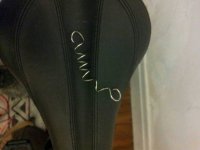Velcro01 said:
neptronix said:
If you have a lyen/infineon controller, the default phase amp to battery ratio is something like 3:1, or 60 amp phase to 20 amp battery, for example.
Hi neptronix, could you, or someone else please explain this to me. How can you have more current in a phase compared to what you are drawing out of your battery?
Sorry for the slightly OT question here... :?
Oooh, that's a hard one to explain properly. I think Miles or Liveforphysics explained it to me at one point, but i forgot exactly how they said it, so here's my butchered version.. and if they chime in, listen to them and not me :lol:
Basically your controller is able to dish out a multiple of your battery current at lower to mid RPMs by converting a high voltage into a lower voltage w/higher amperage internally ( this isn't exactly how it does it, but the effect is the same ). This helps you get started from a stop much easier, and also gives you some more power when climbing hills so that the motor doesn't stall out. This is more useful for lower power motors ( like 250w geared motors - 750w DD hubs ) than it is for high power motors where you might be producing 200nm/170ft-lb from a stall, which is certainly good enough :lol:
So let me illustrate this with a motor + controller + battery combination that turns at a maximum of 400rpm under load.
And let's say that you have your battery amp / phase amp set like this: 20A / 60A
At 0RPM, the motor is having 60A pushed into it.
at 100RPM, the motor is having 50A pushed into it.
at 200rpm, the motor is having 40A pushed into it.
at 300rpm, the motor is having 30A pushed into it.
at 400rpm, the motor is having 20A pushed into it.
The above picture is a fairly typical DC motor response curve.
If we use a 3:1 phase amp to battery ratio, we are getting a response similar to this.
But if we use a lower ratio, like 2:1, those amps look like this:
At 0rpm, the motor gets 40A.
at 100rpm, the motor gets 35A.
at 200rpm, the motor gets 30A.
at 300rpm, the motor gets 25A.
at 400rpm, the motor gets 20A.
And the torque at 0RPM is 33% lower, at mid-speed, you get a little bit less power, but at full speed you get the same power. This is not a big problem because you spend most of your time around full speed in a mid drive system. But you will have to be more careful about being in the correct gear when you are climbing hills, because at lower RPM, the torque will not be as high.
Here's the thing about gears, belts and chain. They can handle more torque the faster they spin. That's fine if you have an internal combustion engine, but you have to oversize things for electric power due to the low end torque

I think that GNG really undersized things here. This keeps the cost down and the weight down, but i think most of you want a mid drive system that lasts more than a few miles, right?

Anyway, tuning down the phase:battery amp ratio should help. Maybe it can be reliable on stock power if you lower the initial torque that way.













